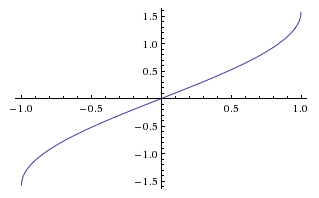Astonishing Property of Inverse Trigonometric Functions

I'm not sure if someone has noticed it before or not.
But anyways, I found this result today,
As @megh choksi suggested in my previous note, I'll not be sharing the proof right now. Instead, I'll wait for a few days for others to try.
Hint - You may read this wiki - Generalizing The Circular Functions
No vote yet
1 vote
Easy Math Editor
This discussion board is a place to discuss our Daily Challenges and the math and science related to those challenges. Explanations are more than just a solution — they should explain the steps and thinking strategies that you used to obtain the solution. Comments should further the discussion of math and science.
When posting on Brilliant:
*italics*or_italics_**bold**or__bold__paragraph 1
paragraph 2
[example link](https://brilliant.org)> This is a quote# I indented these lines # 4 spaces, and now they show # up as a code block. print "hello world"\(...\)or\[...\]to ensure proper formatting.2 \times 32^{34}a_{i-1}\frac{2}{3}\sqrt{2}\sum_{i=1}^3\sin \theta\boxed{123}Comments
Hi Kishlaya , you considering the aspect of doing Research in Maths ? You'd do well . Given the standard of your questions, the ideas and solving techniques that you come up with I think I know who's gonna come out to be the AIR 1 in JEE Advance in a few months . Don't you think so too ?
Log in to reply
Even I think, I know who's gonna be JEE AIR 1.
.
.
.
.
.
Ofcourse, it's you and who else :)
Log in to reply
Dude there is a lot of competition and I can cite examples from Brilliant also with you , Pranjal , Ronak, Megh , Deepanshu topping the list ? Plus Physics and Inorganic Chemistry are Barriers that I have to overcome .
Log in to reply
Same is the story with me. I find Chemistry to be the biggest hurdle that I have to cross anyhow, to get a good rank in JEE.
Log in to reply
Well, I wish you the Best of Luck and hope that we both get into the same IIT and a good one at that !!
Thank you .
@Jake Lai, @Shashwat Shukla , @Azhaghu Roopesh M , @megh choksi , @Pranjal Jain , @Calvin Lin , @Michael Mendrin, @Daniel Liu, @Jon Haussmann @Krishna Sharma
Log in to reply
Yeah , I'm on it . And check out my latest problem Kishlaya , it might be of significant interest to you !!!
Check it out !!!
@Kishlaya Jaiswal , @megh choksi
Log in to reply
Wow, that's an amazing problem and even the title being more amazing. And now, you're completely flattering me. Honestly speaking, I don't deserve that much brag.
You all (each and every Brilliantian) has been my inspiration. :)
Log in to reply
Hey, I have a series of questions planned in which I'll be using concepts I have learned from you . So where do you want me to provide the links to those questions ? Seeing currently you won't get them as soon as I post them .
I'll just prove for ℜ(arcsin(x))=2π∀x≥1 as a HINT for others to prove the rest ⌣¨
We all know that arcsin(n)=−i⋅ln(i⋅n±1−n2)=−i⋅ln(i⋅n±im=−i⋅ln(i(n±m))
Now we use eix=cos(x)+i⋅sin(x)and=ln(i⋅x)=ln(x⋅ei⋅2π)=−i⋅(ln(x)+i⋅2π)=2π−ln(x)
So we get →2π−i⋅ln(n±m)
Therefore ℜ(arcsin(x))=2π
Log in to reply
@Jake Lai Is it possible to make the fonts look big ?
Perfect!!! And similarly, we can work out the other relations too.
Can I say this ?
ℜ(arcsin x)=ℜ(2π−cos−1x)
Thus 2π
Log in to reply
Yep, but not exactly because there will be a contradiction.
Because ℜ(2π−cos−1x)=2π−ℜ(cos−1x)
And then you need to make assumption that ℜ(cos−1x)=0
And then to prove the above assumption, you will again need ℜ(cos−1x)=ℜ(2π−sin−1x)
Log in to reply
I mean for x>0 , arc(cosx) will always be imaginary , so real part of will be pi/2.
For cos−1x , the same way you proved,
cos−1x=ilog(x+i1−x2)
For imaginary as well as real , it gives
cos−1x+sin−1x=2π
Please correct me if I am wrong
Log in to reply
Hmm, that seems perfectly reasonable.
Log in to reply
Sorry for the suggestion , now as you wish please you post a wiki on it , will enjoy learning from you.
A request can you post a wiki on double summation.
Log in to reply
Actually, I'll add that to the existing wiki itself.
And yes, I'll try my best to post a wiki on double summation as soon as I get time because I've my board examinations going on so it's a little difficult. Ok, so I'll write little by little each day and once the article gets completed, I'll be posting it.